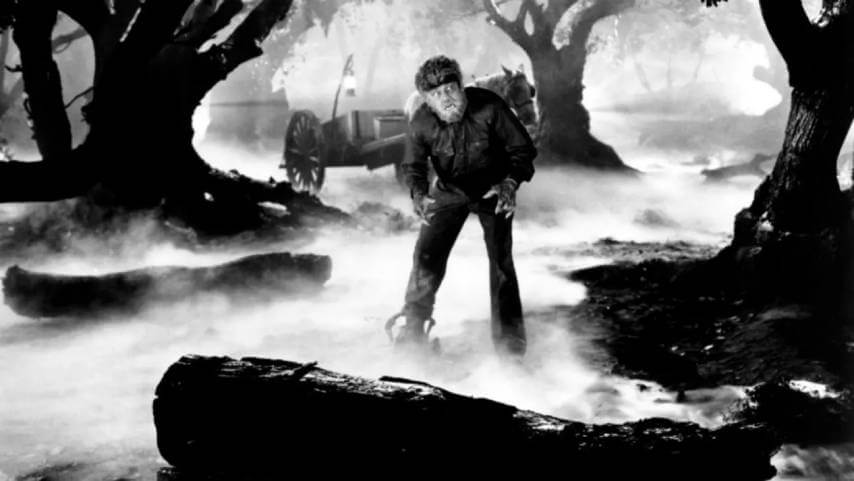Film Trivia Fact Check: Original The Wolf Man script kept the werewolf at bay
Did screenwriter Curt Siodmak want a non-transforming Wolf Man?
Photo: Universal Pictures
The internet is filled with facts, both true and otherwise. In Film Trivia Fact Check, we’ll browse the depths of the web’s most user-generated trivia boards and wikis and put them under the microscope. How true are the IMDb Trivia pages? You want the truth? Can you handle the truth? We’re about to find out.
Claim: In Curt Siodmak’s original script for the film, whether or not Lawrence Talbot really underwent a physical transformation into a werewolf or if the transformation simply occurred in his mind was left ambiguous. The Wolf Man was never to appear onscreen. Ultimately, the studio determined that Talbot’s literal transformation into a werewolf would be more appealing to the audience and, thus, more profitable. The script was revised accordingly. The remake of the film starring Benicio Del Toro leaned into this idea, having its version of Lawrence Talbot admitted to an asylum for “delusions” of lycanthropy. [Source: IMDb.com]
Rating: True.
Context: The Wolf Man was hardly the first werewolf to bark at the moon. Cases of lycanthropy trace back to antiquity, with regular outbreaks occurring in the Middle Ages, Bram Stoker’s Dracula, and Universal’s 1935 feature Werewolf Of London. But Universal’s Lon Chaney Jr.-led classic introduced many tropes still used today, including silver bullets, contagious bites, and, perhaps, most importantly, bodily transformation. Thanks to An American Werewolf In London and Rick Baker’s Oscar-winning effects, the bonecracking transformation of the human frame into canine form is the genre’s main sizzle. Like a crackling plate of fajitas, Universal presented its 2025 transformation online in the marketing push for its latest version of the story, Wolf Man. But as crucial as it is now, a man morphing into a wolf was not a part of Curt Siodmak’s original script.
Despite Siodmak bragging in his memoir, Wolf Man’s Maker, that the script “poured painlessly into my typewriter, scene by scene, without much of a change,” much of his script changed. Universal cut his 135-page shooting script to a tight 70 minutes. Among the most significant changes from script to screen were a filmed (but now lost) scene where Chaney fights an elderly bear, and an unresolved question around whether or not his character, Larry Talbot, was actually turning into a wolf or simply imagining it. On page 128 of his original script, Siodmak outright notes that audiences should never see a clean shot of the monster’s face.
“The creature has turned around and we only see his back,” Siodmak writes. “He looks like Larry from this angle, but he walks like an animal, soft-footed, wary. Note: The wolf-man’s face is never seen—ONLY IN THE MIRROR OF THE WATER—SEEN THROUGH LARRY’S EYES—AS HE IMAGINES HIMSELF. The monster dashes into the bushes and disappears.”
The Wolf Man was an assignment for Siodmak, who recalled getting the title and a deadline. Though he was only working off a title, Siodmak “saw in it the fight of good and evil in a man’s soul and the inescapable working of fate, which also shaped my life.” It wasn’t uncommon for Siodmak to inject his interests into his writing, including The Wolf Man. “If you look at all of the films, stories, everything that Siodmak has ever written, it involves some kind of brain or personality transplant,” Michael Mallory, author of Universal Studios Monsters: A Legacy Of Horror, tells The A.V. Club. “It’s always a Jekyll and Hyde theme. Even if he was assigned this picture, he put his own philosophy into it.”
That philosophy runs throughout Siodmak’s original script, which was further refined once the cameras started rolling. In the script, Larry isn’t the son of a Welsh aristocrat but an American technology specialist in Europe to repair a telescope, and his status as an outsider informs his lycanthropy.
“He thinks that he’s turning into a wolf because he comes to a strange country where there’s 19th-century Romani people with cars and telephones, that weird Universal European Netherland that all of their movies are set in,” says Mallory. “He succumbs to the folklore and believes he turns into a wolf. So, the only time you ever saw any werewolf makeup was reflective.”
Obviously, that wasn’t going to fly with Universal, a studio in dire straits in the early ’40s, which figured bringing mummies, vampires, and, yes, transforming werewolves back to theaters would, in turn, bring back audiences. The studio literalized the transformation and gave the monster some much-needed screentime, allowing makeup artist Jack Pierce to refine some ideas from Werewolf In London and craft one of the most iconic effects on one of Hollywood’s great canvases: Lon Chaney Jr.’s mug.
Despite the changes, Siodmak’s ambiguity remains. Rarely does anyone actually see the werewolf in The Wolf Man, and those who do tend to die. Could the transformation be Talbot’s projection of how he thinks he looks? Later, Siodmak took another stab at internalized transformation, a monsterless monster movie with a different animal.
“In 1951, he made a picture called Bride Of The Gorilla, which is virtually a remake of The Wolf Man, except instead of a wolf, it’s a gorilla,” Mallory tells us. “Raymond Burr plays the guy who thinks he’s turning into an animal. And in it, you only see the gorilla in a reflection in a mirror. Otherwise, it’s just in his imagination. And that’s what Siodmak wanted, and eventually, he got to do it.”